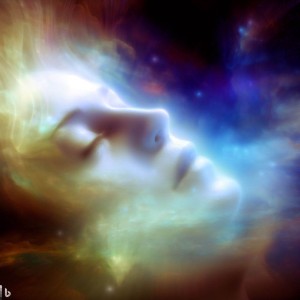Whispers in the Night: Deciphering the Lucid Dreams Meaning in Our Silent Slumbers

Lucid dreams, a fascinating realm where dreamers know they’re dreaming, hold profound meanings for many. These vivid nocturnal experiences can offer insight into our subconscious. Understanding their symbolism might unlock deeper aspects of oneself and the significance of these conscious dream states. Dive into the world of lucid dream interpretations.
I. Introduction
A. The Tapestry of Conscious Nocturnal Adventures
Lucid dreams stand out from our regular nightly visions, often described as the intersection between consciousness and the ethereal realm of dreams. A lucid dream is not merely a dream; it’s an experience where the dreamer becomes aware that they’re within a dream. Unlike the passive nature of regular dreams, where one is simply an observer, one can often control and shape the environment, characters, and even the narrative in lucid dreams. This awareness transforms the dream into an interactive realm, a playground of the mind where the boundaries between reality and imagination blur. It’s as if the dreamer has been handed the director’s chair in the film of their subconscious, allowing them to script, act, and watch simultaneously.
B. The Gateway to Inner Reflection
Beyond the sheer wonder and amusement, these dreams provide, they also serve a deeper, more profound purpose. By understanding the meanings behind lucid dreams, we have a rare opportunity to delve into the intricacies of our innermost thoughts, desires, and fears. They can act as mirrors, reflecting our subconscious mind’s nuances, often revealing hidden aspects of our personalities or unresolved issues. Just as an artist finds meaning in every brushstroke or a writer in every word, the scenes, characters, and emotions within lucid dreams carry significant messages. Unlocking these can lead to greater self-awareness, healing, and personal growth. The exploration of lucid dream meanings is not just a pursuit of dream enthusiasts but a journey into the heart of human consciousness.
II. Historical Context of Conscious Dreaming
A. Whispers from the Ancients: Ancient Civilizations’ Perspectives on Aware Dreaming
From the sand-swept pyramids of Egypt to the lofty temples of Greece, lucid dreaming has intrigued, mystified, and enlightened various ancient civilizations. The Egyptians, for instance, viewed dreams as messages from the gods, with some hieroglyphic texts hinting at dreamers being “awake” within their dreams, suggesting a form of lucidity. The Greeks also had a term for it: “euknemonides” dreams were those in which dreamers realized they were in the middle of a dream. Notably, the famous philosopher Aristotle mentioned such experiences, suggesting that there’s a state where dreamers are aware of the dream itself. In many indigenous cultures, shamans and tribal leaders would harness the power of conscious dreaming of seeking guidance, healing or even embark on spiritual quests. For these ancient civilizations, the realm of lucid dreaming was not just a nocturnal diversion but a spiritual bridge connecting them to deities, ancestors, and inner wisdom.
B. From Myth to Microscope: Early Scientific Investigations
As time progressed and the world shifted from mysticism to empirical, lucid dreaming began to catch the eye of the scientific community. One of the earliest documented studies was in the late 19th century by Marquis de Hervey de Saint Denys, a French sinologist who meticulously chronicled his lucid dreams. But in the 20th century, with advancements in neuroscience and sleep research, the scientific study of lucid dreaming took off. In the late 1970s, Keith Hearne, a British parapsychologist, devised an experiment proving the existence of lucid dreaming using eye movement signals. This groundbreaking research paved the way for further exploration, shifting the narrative from mere anecdotal accounts to verified scientific phenomena.
III. Deciphering Lucid Dreaming Symbols
A. The Language of the Subconscious: Common Symbols and Their Interpretations
Dreams, particularly lucid ones, are brimming with symbols that can sometimes baffle even the most astute dreamers. Certain motifs, however, appear universally and have been studied and interpreted across cultures. Labyrinths or mazes represent one’s search for clarity or a solution to a problem. Flying, a popular experience in lucid dreams, could symbolize a desire for freedom or escape. Depending on its state, water might denote emotions; calm waters can indicate serenity, while turbulent waves might hint at suppressed feelings or turmoil. By understanding these recurring symbols, one can decode the messages their subconscious is trying to convey.
B. The Personal Palette: How Experiences Shape Dream Imagery
While there are universal symbols, one’s personal experiences play a pivotal role in shaping dream imagery. A childhood home, a forgotten melody, or even a scent from the past can make its way into the dream realm, each with its significance. These personal symbols are deeply intertwined with memories, emotions, and individual experiences. For instance, a person who fears heights might dream of standing on a precarious ledge, indicating their vulnerability or anxiety in a real-life situation. Conversely, someone who has achieved a recent accomplishment might dream of scaling a mountain, symbolizing their feelings of triumph. These personalized symbols underscore the importance of introspection and self-awareness in understanding and interpreting lucid dream imagery.
IV. Benefits of Understanding Lucid Dream Meanings
A. Healing from Within: Emotional Healing and Resolution
By accessing and comprehending the messages of lucid dreams, individuals open the door to profound emotional healing. Lucid dreams can be safe spaces for confronting traumatic memories, pent-up emotions, or unresolved conflicts. For instance, someone grappling with loss might find solace by interacting with a loved one in their dream, allowing for closure. Others might face and conquer personal fears, helping them to overcome anxieties in their waking life. This form of dream therapy can be instrumental in releasing emotional blockages and promoting mental well-being.
B. The Wellspring of Inspiration: Enhanced Creativity and Problem-Solving
Many artists, writers, and innovators attribute bursts of creativity to insights from their dreams. Given their vivid and interactive nature, lucid dreams can be a treasure trove for fresh ideas and novel solutions. Salvador Dali, the surrealist artist, often sourced inspiration from his dreamy escapades. Furthermore, the malleable environment of a lucid dream allows dreamers to simulate scenarios, experiment with ideas, or practice skills, often leading to unexpected resolutions to real-world problems.
C. Diving Deep: Connection to One’s Subconscious
Lucid dreams offer an unfiltered connection to the subconscious mind. Understanding dream meanings gives one an intimate glimpse into their hidden desires, fears, aspirations, and beliefs. This deep self-awareness can lead to personal growth, aiding individuals in aligning their actions with their core values, discovering their true passions, and understanding the root causes of certain behaviors or feelings.
V. Techniques to Induce and Interpret Lucid Dreams
A. Navigating the Dreamscape: Methods to Achieve Dream Lucidity
Achieving lucidity within dreams isn’t purely coincidental; some techniques can increase its likelihood. The ‘MILD’ technique (Mnemonic Induction of Lucid Dreams) involves repetitive affirmation about becoming lucid before sleeping. Reality checks, where one develops the habit of questioning reality throughout the day, can carry into dreams, prompting lucidity. And then there’s the ‘Wake Back to Bed’ method, where one interrupts their sleep to increase the chances of entering a lucid dream during the next REM cycle.
B. Chronicle of the Mind: Dream Journals and Their Significance
Maintaining a dream journal is a cornerstone in inducing and interpreting lucid dreams. Recording dreams immediately upon waking helps retain dream details, recognize patterns, and understand recurring symbols. Over time, this practice improves dream recall and sharpens one’s ability to discern and derive meanings from dream narratives.
C. Guided Exploration: Role of Dream Therapists and Guides
Dream therapists or guides can assist those seeking deeper insights or struggling with interpretation. Drawing from psychological principles and dream theory, these professionals can provide a structured approach to unraveling dream meanings, offer techniques to enhance lucid dream experiences and support navigating challenging or intense dream content. Their expertise bridges the dreamer and the often enigmatic world of lucid dreams.
VI. Real-world Applications of Lucid Dream Insight
A. Journey to Self-Actualization: Using Dreams for Personal Growth
Lucid dreams, with their vivid clarity and conscious interaction, offer a direct channel to one’s inner psyche. This insight can be transformative for personal growth. By interpreting the meanings of lucid dreams, individuals can pinpoint areas needing attention or change. It might be mending a strained relationship, pursuing a dormant passion, or shifting a counterproductive mindset. The dream world offers reflection and guidance, assisting dreamers in navigating their journey toward self-actualization.
B. Mastery of the Mind: Enhancing Skills and Overcoming Fears
The malleable environment of lucid dreams provides a unique training ground. Athletes, musicians, or anyone looking to refine a particular skill can use these dreams for practice, often leading to enhanced real-world performance. Similarly, lucid dreams provide a controlled setting to face and overcome fears. Someone with acrophobia, for example, might practice standing on a high ledge in their dream, gradually desensitizing their fear of heights.
C. Healing the Psyche: The Potential for Therapeutic Treatments
The therapeutic potential of lucid dreaming is vast. From treating nightmares and PTSD to aiding in grief counseling, lucid dreams’ controlled and conscious environment offers a healing space. Patients can confront traumatic memories, practice coping mechanisms, or engage in symbolic acts of healing. As research progresses, integrating lucid dreaming into therapeutic practices may revolutionize mental health treatments.
VII. Criticisms and Misunderstandings
A. The Skeptic’s Viewpoint: Debates on the Conscious Dream State’s Legitimacy
Despite growing scientific validation, lucid dreaming still faces skepticism. Some critics argue that individuals perceive transparency as merely a dream feature rather than a conscious awareness. Others believe that the recalled experience of control in a lucid dream is an illusion, questioning the very foundation of the phenomenon. These debates highlight the challenges of studying subjective experiences and the need for more rigorous scientific exploration.
B. Traversing Dream Myths: Misconceptions about its Significance and Safety
As a niche area of study, lucid dreaming is surrounded by misconceptions. A common myth is that it can “trap” individuals in a dream state, leading to fears about its safety. Another misconception is overemphasizing its spiritual significance, with some viewing every dream symbol as a profound revelation. It’s essential to approach lucid dreaming with a balanced perspective, understanding its potential benefits and limitations. While it’s a powerful tool for introspection and growth, like any tool, its effectiveness and safety depend on its usage and understanding.
FAQs
Q: What exactly is a lucid dream?
A: A lucid dream is a dream in which the dreamer is aware that they are dreaming. This awareness can vary in intensity; in some cases, the dreamer can control aspects of the dream environment or narrative.
Q: Is there a specific meaning behind every lucid dream?
A: Not necessarily. While many lucid dreams carry significant personal or symbolic meaning, others might be random or influenced by recent events. The meaning often depends on the individual’s personal experiences and subconscious thoughts.
Q: Can understanding lucid dream meanings improve mental health?
A: Yes, in many cases. By interpreting and addressing the themes and emotions in lucid dreams, individuals can gain insights into their subconscious, leading to emotional healing, resolution of inner conflicts, and overall personal growth.
Q: How reliable are interpretations of lucid dreams?
A: Interpretations are subjective and vary based on individual experiences, cultural backgrounds, and beliefs. It’s beneficial to approach interpretations with an open mind, considering both universal symbols and personal contexts.
Q: Is lucid dreaming safe?
A: For most people, lucid dreaming is a safe and natural phenomenon. However, excessive attempts to induce lucid dreams or get overly immersed can disrupt sleep patterns. It’s always best to approach it in moderation and consult professionals if uncertainties arise.
Q: Can everyone experience lucid dreams?
A: While most people have the potential to experience lucid dreams, the frequency and intensity vary among individuals. Some might have them naturally, while others need to practice specific techniques to induce them.
Q: Are lucid dreams the same as dream control?
A: Not exactly. While lucid dreaming involves awareness within the dream, it doesn’t always come with the ability to control it. Dream control is a facet of lucid dreaming where the dreamer can actively influence events, settings, or characters in the dream.
Conclusion
A. The Dreamer’s Epilogue: Reiterating the Value of Understanding Lucid Dream Meanings
The realm of lucid dreaming, with its intricate tapestry of symbols, emotions, and narratives, offers a profound gateway into the human psyche. By striving to understand the meanings behind these conscious nocturnal adventures, one embarks on a journey of introspection, growth, and healing. The insights gleaned can illuminate hidden corners of one’s mind, leading to revelations about desires, fears, and aspirations.
B. A Call to the Curious Mind: Encouragement for Further Personal Exploration of Aware Dreaming
To every dreamer, the world of lucid dreams beckons with its promise of discovery and understanding. Embracing this world, with its mysteries and wonders, is an invitation to deepen one’s connection with the subconscious to harness its potential for creativity, healing, and growth. It’s an encouragement to continually explore, question, and marvel at the boundless landscapes of the dreaming mind.
Suggested Readings
The enigmatic world of lucid dreaming has been the subject of much exploration in spiritual traditions and modern psychology. For those intrigued by the deeper implications and meanings of their lucid experiences, a wealth of literature awaits. Here are some recommended titles that delve deeply into understanding the lucid dreams meaning:
- “The Labyrinth of Lucidity: Navigating the Depths of Lucid Dreams Meaning” by Dr. Helena Montague. A comprehensive exploration into lucid dreaming, Dr. Montague combines years of research with personal anecdotes, offering readers a deep dive into understanding the profound meanings behind their dreams.
- “Dreams Unveiled: The Subconscious Alchemy of Lucid Dreams Meaning” by Lucas Greene. Greene’s philosophical approach juxtaposes ancient dream traditions with contemporary dream analysis. His work is a meditation on the essence of dreaming consciously.
- “Lucid Echoes: Interpreting the Silent Language of Lucid Dreams Meaning” by Prof. Miriam Kessler. Prof. Kessler offers an academic yet accessible take on the subject, delving into the symbols, narratives, and emotions that lucid dreams often convey.
- “Waking Within the Dream: A Journey through the Lucid Dreams Meaning” by Alex Thornwood. Thornwood’s narrative approach interweaves personal experiences with scientific insights, offering readers a unique perspective on the interpretative journey.
- “The Lucid Dreamer’s Codex: A Guide to Understanding Lucid Dreams Meaning” by Serena Willow. This guidebook is a practical tool for beginners and seasoned dreamers, providing techniques, insights, and interpretations to uncover the rich tapestry of lucid dreaming.
The quest for understanding the mysteries of the dreaming mind is a journey without an end. Each book offers a unique lens to view and interpret lucid dreams’ dynamic and vivid world. Happy dreaming and reading!






